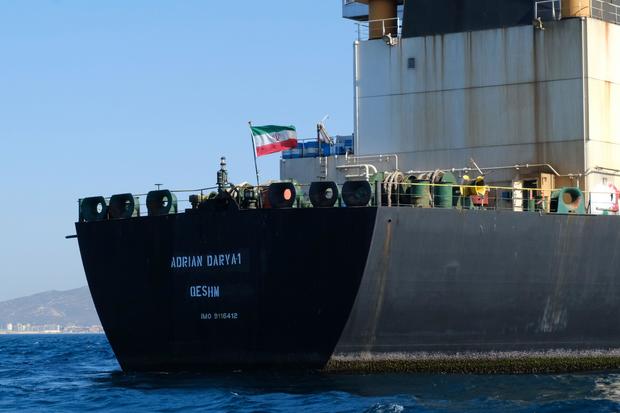One Thing Analysts Agree On: To Disagree
"Iran is a black box, but it's also not black box [given other ways to reveal secretive activity]."
Iran is simply doing a better job of putting their oil into other people's hands -- or their own storage tin-cans -- than anybody has expected."
"[We can detect] a substantial amount of production above and beyond [other assessments]."
"We have seen every tin-can that they have get filled up, and we've seen oil fill up in areas that they haven't historically used."
"They're going to hit a brick wall at some point, and their production is going to take another leg down."
Devin Geoghegan, global director of petroleum intelligence, Genscape, Inc., Denver, Colorado
 |
| An oil tanker loads gas at Assaluyeh in the Gulf: © Reuters |
"Iran is as secretive now as any time over the past forty years. There's a wide array of diverging estimates of their exports in the industry, with a series of accounting problems causing erroneous higher numbers to come into some of these things."
"The Trump administration has been successful at curtailing Iran's exports on an unprecedented scale."
Daniel Gerber, chief executive, Petro-Logistics SA, tanker-tracking, Geneva
"The goal of bringing Iran's exports down to zero was never attained."
"The Trump administration has been obviously very successful in bringing maximum pressure."
Homayoun Falakshahi, analyst, Kpler analytical company, Paris
 |
| Iranian crude oil tanker, Adrian Darya 1. |
In its effort to attempt avoiding detection, Iran is employing a wide range of techniques, including "several ship-to-ship transfers off-radar", stated Kpler analyst Samah Ahmed. His firm relies on commercial satellite imagery, cross-referencing these images with other data such as customs and reports from port agencies to lead them to the estimate that Iran has managed to maintain limited oil deliveries to China, its largest customer, as well as some flows to Turkey and Syria.
The world's attention has been focused on the whereabouts of the Adrian Darya 1 tanker, first when it was seized near Gibraltar by the United Kingdom military in July, and then more lately when it was detected through satellite imagery near the Syrian port of Tartus. But the world of serious oil watchers is captured instead by a much larger mystery; the whereabouts of Iran's fleet of oil tankers dispatching oil secretively bypassing U.S. sanctions.
Through their professional curiosity to understand the methodology behind Iran's madness, newer methods of tracking ships require an inventive approach, leading to divergent perceptions on the amounts of crude slipping into world markets. The mystery revolves around the fact that those Iranian vessels have "gone dark", as a result of the tightened sanctions, by switching off their transponders revealing their locations.
The Trump administration is pressuring Tehran in the wake of the American rejection of the previous nuclear accord. Iran is disinterested in any further negotiations to update that accord to include vital issues the previous one deliberately overlooked in the knowledge that the Islamic Republic would balk at any demand that it stop its ballistic missiles program, much less its support for terrorism. In response, Iran has acted out in hostile, aggressive events, from targeting Saudi oil tankers to shooting down an American spy drone.
 |
Crude traders are puzzled and looking to find insights into the cloak-and-dagger theatre that has the potential of influencing global oil prices, in the face of the U.S. State Department's intention to shrink Iran's exports to "zero", which had Iranian Oil Minister Bijan Zanganeh insisting he is working "day and night" to maintain sales with a number of clandestine operations. Tracking companies agree on one issue; the U.S. has not yet seen its goal achieved, with oil still flowing.
The thing of it is, despite all their methods of investigation the analysts cannot agree on how much oil continues to flow, where daily exports could range between a couple of hundred thousand barrels on up to a million daily, as was shipped under the previous sanctions of Barack Obama. Barely a third of that total is now sold, given the more constraining sanctions imposed more latterly. Mr. Gerber of Petro-Logistics claims to be obtaining details on the volumes and crude-type of cargoes along with counter-parties buying them.
Yet according to Kpler, exports have been choked, slumping 90 percent since the abandonment of the nuclear pact, delivering just 400,000 barrels a day. And according to Sara Bakhshouri, head of consultants SVB Energy International in Washington, the actual volume being sold for cash is likely even lower, with some cargoes sold to China in repayment of debts, others being moved into bonded storage, bypassing customs. Total sales in July were estimated to have been as little as 100,000 barrels a day, she claims.
Iran drills "full speed ahead" at new fields in the West Karoun region, points out Mr. Geoghegan who uses satellite photos of gas flaring at oilfields to gauge the activity levels and calculate production. He estimates a large amount of additional production, not being sold, moving into storage, including underground facilities, and others being kept at sea. And, as storage fills, output will have to be lowered.
None of this has yet restrained Iran in any measure for its support, financial and with the provision of troops via the IRGC and Hezbollah to trouble spots like Yemen and Syria and Gaza.

Labels: Iran, Nuclear Agreement, Oil Shipments, Sanctions, United States

<< Home